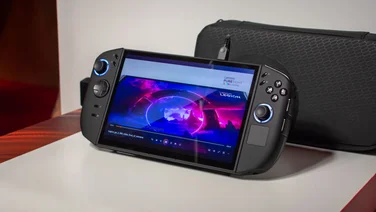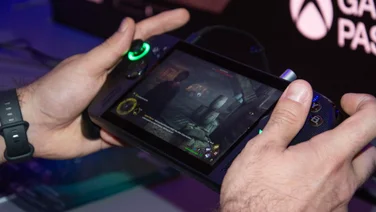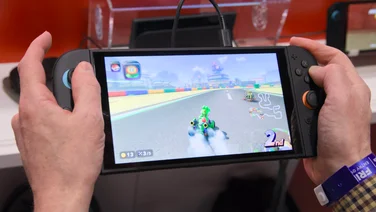To help us provide you with free impartial advice, we may earn a commission if you buy through links on our site. Learn more







We’ve been holding off giving our opinion on Nintendo’s much-hyped 3D handheld, largely because we were waiting for some actual games to play on, which turned up just yesterday – a couple of weeks after the hardware. Here, you can read our impressions of the Ubisoft 3DS lineup. The good thing about the wait, is that it’s given us lots of time to consider this intriguing device and its many capabilities.
The original DS came out in 2005 in the UK and was then followed by the slimmer DS Lite, the fancier DSi and the larger DSi XL. Despite their differences all these consoles had the same core hardware and ran the same games. Between the various iterations Nintendo has sold around 145 million units – making it one of the most popular games consoles ever. The 3DS is the first true successor to the DS range, completely reworked with a new processor, graphics chip, control layout and, of course, that much-publicised 3D display.

Our initial impressions of the 3DS were much along the lines of the original DS. The hardware itself is rather ungainly, formed of three different layers, which on our review sample are exaggerated using varying shades of blue. The 3DS doesn’t possess the smooth continuous exterior so beloved of, say, Apple’s gadgets – but instead has a rather higgledy-piggledy appearance. It isn’t that small either, measuring 21x134x74mm, around the same size as its DSi predecessor. This isn’t surprising given the insane amount of buttons and gadgets that Nintendo have stuffed into the casing. So let’s breakdown what’s here.
3DS SCREENS
The Nintendo DS was always defined primarily by its twin screens and the lower display’s touch screen interface, but now both screens have a neat trick. The 3D display at the top has generated a lot of fuss, overshadowing the rest of the hardware. It’s certainly impressive if you haven’t seen a glasses-free 3D display before using parallax barrier technology – such as the Fujifilm FinePix Real 3D W3. It takes a few seconds for your eyes to focus properly the first time, but then everything springs into 3D.
Its 3.5in across and has 800×240 pixels, that’s 400×240 pixels per eye – far more than the 256×192 pixels used in the DSi screens. In terms of graphical prowess, it’s far too early to make a proper judgement based on the games we’ve seen – but so far we’d describe its polygon pushing power as capable rather than mind-blowing.

There’s a slider on the side if the display that supposedly controls how 3D the display is, but we found that you might as well have it turned all the way up. This gives the best depth effect and we didn’t find that moderating the 3D made a big difference to how tired our eyes felt. Speaking of this, it makes a big different depending on what kind of game you’re playing. Anything that requires long periods staring intently at the screen quickly tired out the muscles around our eyes – so driving games were challenging, while anything that made us switch back and forth between the two screens was far easier. It may be that over the weeks our eyes will get used to the display, but it’s too early to say for sure.
One thing we will have to change about our game playing style is the amount of unintentional hand waving that goes on. Whether its steering a car or making jumps in a platformer, we usually find ourselves trying to get a little extra by pointlessly waving the console around as we play. However, the screen has a relatively small tolerance for such things, before the 3D effect becomes simply a blur, so we’ll need to learn to sit still when we play.
The 3D display only provides the merest hint of things protruding from it, and it’s a good thing too as on such a tiny screen the illusion would soon be shattered unless the object was coming straight at you. Instead, it’s mainly set to provide a palpable sense of depth into the game. This effect makes the screen feel far bigger and more immersive than it would otherwise, like a little virtual world is actually inside your DS, instead of just being simulated by it. In short it’s a lot more magical than Apple’s iPad ever will be.
The touchscreen is largely unchanged from previous models. Disappointingly it’s still a resistive design, rather than the capacitative touchscreens we’re used to on smartphones. This means you need to give it a definite poke to get it to react. Around the back of the DS is a slot with a small two-part telescopic stylus, very handy for precise inputs on that resistive touchscreen. On the plus side, the new touchscreen is more detailed than the DSi touch screen, with a resolution of 320×240 pixels.
3DS CONTROLS
Aside from the touchscreen, Nintendo has packed a bevy of controls onto the relatively compact 3DS. The most important of these is the analogue thumbpad on the left. This sits very tight to the console in a small circular recess, its slides around rather than tilting and doesn’t click in as an extra button. As an analogue input device it’s excellent, providing nuanced control in every game we tried. Below this is the usual d-pad, which has a nice responsive, clicky feel to it (but no it’s not micro-switched like the old Neo-Geo pocket pad).

On the right-hand side are four small face buttons – it’s a pity that Nintendo didn’t decide to put a second analogue stick here (as we already noticed in Splinter Cell 3D). Such a stick would have made the 3DS far more suited to third-person shooters. This was something that plagued Sony’s PSP, but then Nintendo might have been hoping for a different kind of game on the 3DS, rather than simply ports of big console shooters.
Beneath the touchscreen are three flush buttons. These need a firm press to activate, but that’s no bad thing, as they don’t get in your way when you’re using the touchscreen and won’t be pressed by accident. The Home button works like the Xbox 360’s Guide button, in that it suspends your game and brings you out to the main menu, while select and start cover various in-game options. Other buttons include power, and the two small shoulder buttons, useful in games but which also act as the shutter buttons for the three, count them, cameras.
3DS CAMERA
To go with the 3D screen Nintendo has gone with a pair of cameras on the outside of the lid for taking 3D photos. Don’t expect stellar quality, as they’re only 0.3-megapixel sensors. Shooting in low-light is also out of the question with poor sensitivity, plenty of noise and no LED flash to provide assistance. The angle is surprising tight too, so you often find yourself edging back from your subject.
The resulting photos range from the banal to the jaw-dropping. With a bit of thought in your compositions you can get some great shots, ones that really make use of the 3D element. We can’t show you any examples, unfortunately, but even if you consider it to a be a gimmick, it’s a hugely entertaining one and there’s a lot of fun to be had experimenting with the effect.
A second camera on the inside of the 3DS allows you to take photos of yourself, usually to add a personal touch to games. Or just for the taking of amusing self portraits.

Built-in wireless is no surprise on a DS console. Its functions are largely divided into two areas: Streetpass and Spotpass. The first allows the 3DS to detect and communicate with other 3DS consoles while in sleep mode. This could allow it to find passing players for a multiplayer game and alert you to their presence. Bette still it can swap information with other players as they go about their business, for example you can share Mii avatars with people, who then populate their virtual worlds. It could also provide bonuses in specific games, for example, by trading unwanted objects or treasure with other automatically.
Spotpass also works while the 3DS is asleep, and allows it to download new content from wireless hotspots. For example, your local game store could be offering free in-game content for anyone who brings their 3DS into the store on the launch day of a new title.
3DS GAMES
The real question then is whether developers can make use of all these disparate technologies and bring them together in brilliant games. The 3DS takes similar-looking cartridges to previous DS consoles, but with a tab so they won’t fit in older devices. Old games are fully compatible with the new device, so you can play old favourites, or plunder the back catalogue if you’re new to all this.

Nintendo provides a series of mini-games with the DS that showcase how its various features can be brought together to make something truly excellent and entertaining happen. The most impressive of these are the Augmented Reality (AR) games, but it’s far easier to show these than describe them, so here’s a short video we made.
As you can see the camera and processing power of the 3DS combine excellently to create a really intriguing little game. What you can’t get from this is how much the 3D element of the screen adds to the experience, making the AR far more believable and immersive.
Another example that ships with the console is Face Raiders, a rather silly game that captures your face, squishes it into a flying armoured helmet and then makes you chase it around the room shooting it. We’ve seen games like this before, but Nintendo have outdone them all, and the 3D effect again adds a lot to this kind of virtual play.

CONCLUSION
The best way to summarise the Nintendo 3DS then is as an ugly duckling. It doesn’t seduce at first glance, with its appearance governed by a bewildering mess of technology, but then Nintendo pull something cute out of the mess, something that makes you laugh like a delighted child, and suddenly it all comes together.
Just like the original DS, it’s now down to software publishers to tease those magical moments from this Frankenstein device. It’s very hard to rate any console at the beginning of its lifespan; but what’s here should create many possibilities for genuine innovation. We’d be amazed if the 3DS fails to bring us exciting new experiences. We’re therefore giving it a Best Buy award, if only for its incredible untapped potential.
Remember to read our Ubisoft 3DS lineup article now.
| Details | |
|---|---|
| Price | £197 |
| Rating | ***** |
| Award | Best Buy |






